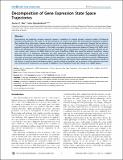| dc.contributor.author | Mar, Jessica Cara | |
| dc.contributor.author | Quackenbush, John | |
| dc.date.accessioned | 2010-11-10T16:42:43Z | |
| dc.date.issued | 2009 | |
| dc.identifier.citation | Mar, Jessica C., and John Quackenbush. 2009. Decomposition of Gene Expression State Space Trajectories. PLoS Computational Biology 5(12). | en_US |
| dc.identifier.issn | 1553-734X | en_US |
| dc.identifier.uri | http://nrs.harvard.edu/urn-3:HUL.InstRepos:4553228 | |
| dc.description.abstract | Representing and analyzing complex networks remains a roadblock to creating dynamic network models of biological processes and pathways. The study of cell fate transitions can reveal much about the transcriptional regulatory programs that underlie these phenotypic changes and give rise to the coordinated patterns in expression changes that we observe. The application of gene expression state space trajectories to capture cell fate transitions at the genome-wide level is one approach currently used in the literature. In this paper, we analyze the gene expression dataset of Huang et al. (2005) which follows the differentiation of promyelocytes into neutrophil-like cells in the presence of inducers dimethyl sulfoxide and all-trans retinoic acid. Huang et al. (2005) build on the work of Kauffman (2004) who raised the attractor hypothesis, stating that cells exist in an expression landscape and their expression trajectories converge towards attractive sites in this landscape. We propose an alternative interpretation that explains this convergent behavior by recognizing that there are two types of processes participating in these cell fate transitions—core processes that include the specific differentiation pathways of promyelocytes to neutrophils, and transient processes that capture those pathways and responses specific to the inducer. Using functional enrichment analyses, specific biological examples and an analysis of the trajectories and their core and transient components we provide a validation of our hypothesis using the Huang et al. (2005) dataset. | en_US |
| dc.language.iso | en_US | en_US |
| dc.publisher | Public Library of Science | en_US |
| dc.relation.isversionof | doi:10.1371/journal.pcbi.1000626 | en_US |
| dc.relation.hasversion | http://www.ncbi.nlm.nih.gov/pmc/articles/PMC2791157/pdf/ | en_US |
| dash.license | LAA | |
| dc.subject | computational biology | en_US |
| dc.subject | systems biology | en_US |
| dc.subject | genomics | en_US |
| dc.title | Decomposition of Gene Expression State Space Trajectories | en_US |
| dc.type | Journal Article | en_US |
| dc.description.version | Version of Record | en_US |
| dc.relation.journal | PLoS Computational Biology | en_US |
| dash.depositing.author | Mar, Jessica Cara | |
| dc.date.available | 2010-11-10T16:42:43Z | |
| dash.affiliation.other | SPH^Student Stipends | en_US |
| dash.affiliation.other | SPH^Biostatistics | en_US |
| dash.affiliation.other | SPH^Biostatistics | en_US |
| dc.identifier.doi | 10.1371/journal.pcbi.1000626 | * |
| dash.contributor.affiliated | Mar, Jessica Cara | |
| dash.contributor.affiliated | Quackenbush, John | |
| dc.identifier.orcid | 0000-0002-2702-5879 | |


